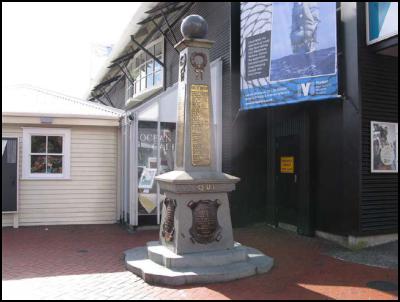Landmark war memorial up for registration

Thursday April 17
MEDIA RELEASE
Landmark war memorial up for registration
The historic value of the earliest known built World War I monument erected in New Zealand is in being assessed by the country’s lead heritage agency.
Heritage New Zealand (formerly the NZ Historic Places Trust) has proposed the First World War Memorial Beacon on Auckland’s waterfront for registration as a Category 2 historic place.
“In light of the 100th anniversary of the beginning of the First World War later this year, the preparation of a registration proposal for the beacon is very timely,” says Heritage New Zealand’s Registration Adviser, Martin Jones.
“It also ties in strongly with this year’s theme of Heritage and Commemoration as part of the International Day for Monuments and Sites on April 18 – a global celebration of heritage organised by ICOMOS [the International Council on Monuments and Sites].”
The beacon memorial is unusual in that it was created at the same time New Zealand troops were fighting in Gallipoli – indeed the red beacon that once stood at the top of the monument was lit for the first time the same week troops were being evacuated off the Dardanelles in December 1915.
The memorial is also rare in that it was erected by an employer – the Auckland Harbour Board – and commemorates not only those who were killed during the war, but all Harbour Board employees who served. As such it is one of very few occupational monuments erected during the First World War.
“As a major port, Auckland had close trade ties with other parts of the British Empire – particularly after the opening of the Panama Canal in 1914, when British cargo was increasingly shipped directly to the city,” says Martin.
“When war broke out, the Auckland Harbour Board promptly donated a considerable sum of money to the Auckland Patriotic Fund. It was also heavily involved in preparations for the conflict providing storage space for cargo on Queen’s Wharf and organising the departure of the troops from the Auckland wharves.”
In September 1914, for example, 2000 troops cheered by large crowds marched through the city to the wharves to board the troop ships.
The port itself was a centre of activity throughout the war years, and from 1917 the wharves were put under military control and manned with armed guards. An examination anchorage off North Head was established, which monitored vessels coming and going from the port.
From late 1915, the beacon memorial was a central part of the waterfront.
“The beacon was one of comparatively few World War I memorials in New Zealand that served a functional purpose,” says Martin.
Originally standing 5.8 metres high with a clear view to the harbour, the monument consisted of steps, a stone obelisk surmounted by decorative ironwork and an electric lamp illuminating a red beacon at the top which served as a navigation aid.
“A newspaper account of the day describes how launches coming into the landings were required to sight the beacon and then align their craft with a white diamond fixed to the Sailor’s Home behind the beacon before ‘running in’,” says Martin.
“The memorial was basically a functioning navigation marker and as such is believed to be unique in New Zealand, and one of only a few built internationally.”
Functionality apart, the symbolism of the light also suggested a beacon of hope, a shining example and safe return home.
As reclamation along the waterfront took place after the war, the beacon became increasingly distant from the sea. Sometime between 1968 and 1973 the memorial was taken from its original site – near where the Copthorne Hotel is today – when the hotel and the Downtown car park were constructed.
Parts of the dismantled memorial were found in Shed 51 on Bledisloe Wharf in 1999 – though the iron railing, orb and wreaths were never recovered. An anonymous Jewish German benefactor who had immigrated to New Zealand prior to the Second World War offered to fund the restoration and reinstallation of the memorial beacon.
In early 2000 the monument was restored with the plaques and new wreaths attached to the Coromandel granite obelisk, and a new stone ball placed on top of the obelisk to replace the original ironwork and lamp.
Today, the monument stands near the entrance of the Viaduct Basin, bearing the names of Harbour Board employees who served overseas, as well as a list of theatres of war and a plaque commemorating the signing of the Versailles peace treaty in 1919.
People are welcome to make submissions on the proposal to register the memorial beacon – contact mjones@heritage.org.nz. Submissions are due by 4pm on May 5.


 Gordon Campbell: On The Hikoi Aftermath
Gordon Campbell: On The Hikoi Aftermath Justice Committee: Further Decisions About Submissions Process For The Principles Of The Treaty Of Waitangi Bill
Justice Committee: Further Decisions About Submissions Process For The Principles Of The Treaty Of Waitangi Bill Infrastructure New Zealand: Single Agency Needed To Coordinate Climate Adaptation And Recovery
Infrastructure New Zealand: Single Agency Needed To Coordinate Climate Adaptation And Recovery Free Speech Union: Fair Digital News Bargaining Bill Likely To Restrict Access To Information, Polling Shows Most Oppose
Free Speech Union: Fair Digital News Bargaining Bill Likely To Restrict Access To Information, Polling Shows Most Oppose Auckland Transport: Driver Safety Screens Now Rolling Out Across Auckland’s Bus Fleet
Auckland Transport: Driver Safety Screens Now Rolling Out Across Auckland’s Bus Fleet People Against Prisons Aotearoa: 'Expect Resistance' - Community Group Pushes Back Against More Cops With Guns
People Against Prisons Aotearoa: 'Expect Resistance' - Community Group Pushes Back Against More Cops With Guns Greenpeace: New Zealand Drops In Global Ranking On Climate Action
Greenpeace: New Zealand Drops In Global Ranking On Climate Action


